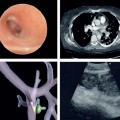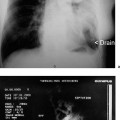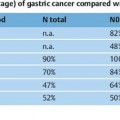4 Miniprobes During the last 15 years, endoscopic ultrasound (EUS) has gained wide acceptance as the method of choice for the local staging of gastrointestinal tumors. It allows visualization of the intestinal wall and of surrounding structures with a resolution unequaled by other imaging modalities. However, EUS continued for a long time to be a specialty requiring expensive equipment, echoendoscopes dedicated to the technique, and special training of examiners. With the advent of flexible high-frequency miniprobes that can be introduced through the working channel of any endoscope, EUS became available as an additional and very powerful diagnostic tool during routine endoscopic procedures. While conventional transabdominal ultrasonography (TUS) using the most sophisticated techniques provides excellent images of almost every anatomical region in the abdomen, miniprobes can be directed to very small structures of interest that can only be targeted under direct endoscopic guidance. It is thought that structures missed on TUS can be identified with miniprobes and vice versa, making the two methods ideal and complementary partners in modern gastrointestinal imaging. After a discussion of a few technical considerations and practical remarks, useful applications of EUS miniprobes (see Table 4.1) and future perspectives for the technique are discussed below, on the basis of the available published evidence and the authors’ experience. Examples are given in various other chapters. Technical Considerations and Practical Remarks Miniprobes for routine diagnostic use are usually high-frequency mechanical scanners with a diameter of 1.7–3.4 mm that can be introduced through the working channel of any flexible endoscope. Frequently asked questions regarding the clinical application of miniprobes include the following. Which frequency should be used? The available miniprobes cover a frequency range of 12–30 MHz, with higher frequencies corresponding to lesser penetration depth. There have been no systematic studies comparing miniprobes of different frequencies for a single application. In the authors’ experience, 20-MHz probes are most useful for all applications. With lower frequencies, visualization of the extramural anatomy and staging of advanced tumors may be easier. However, for the extramural anatomy, conventional EUS with radial or longitudinal scanners provides similar frequencies (7.5–12 MHz) and superior image quality, and for advanced tumors, EUS local staging seems of limited relevance. With higher frequencies (30 MHz), fine resolution of the intestinal wall would be excellent, but with the drawback of losing sight of almost any external structure. As long as there is at best very limited evidence correlating ultrasound morphology with histology, 20 MHz appears to provide the ideal compromise between excellent local resolution and visualization of the relevant surrounding anatomy. At this frequency, with a penetration depth of=2 cm, a considerable part of the abdominal anatomy can be seen. This perigastric and periduodenal (and sometimes also pericolonic) volume of 2 cm comprises the periesophageal area and part of the mediastinal lymph nodes, the aorta, pericardial and pleural fluid, infradiaphragmatic and perigastric lymph nodes, the splenic hilum, celiac trunk, splenic artery and vein, part of the pancreas and pancreatic duct, the left adrenal gland, the distal common bile duct (CBD), and sometimes liver hilum, part of the gallbladder, and free abdominal fluid. In addition, the intestinal wall with adherent lesions is seen with superior resolution. This is true of both intraluminal and intraductal applications; for lesions in the pancreatic or the bile duct, a periductal cylinder of 1–2 cm correctly represents the region of interest.
Application | Targets | Examples |
Examination of structures within or adjacent to the intestinal wall | • Mucosal neoplasias • Submucosal tumors • Myogenic tumors, GIST • Paraesophageal or paragastric lymph nodes • Vascular formations (varices) • All organs within 2 cm of the intestine | • Cancer staging (EEC, EGC, endoscopic mucosal resection) • Differentiation of unknown structures (e.g., cystic vs. solid) • Focal pancreatic lesions |
IDUS | Bile duct and pancreatic duct with surrounding tissue | Small pancreatic and biliary tumors, stones, staging of CCC |
EDUS | Distal bile duct and pancreatic duct | Small CBD stones Small periampullary tumors |
CBD, common bile duct; CCC, cholangiocarcinoma; EDUS, extraductal ultrasound; EEC, early esophageal cancer; EGC, early gastric cancer; IDUS, intraductal ultrasound; GIST, gastrointestinal stromal tumor.
Diameter, rigidity and shape: are they important?
Stay updated, free articles. Join our Telegram channel

Full access? Get Clinical Tree






